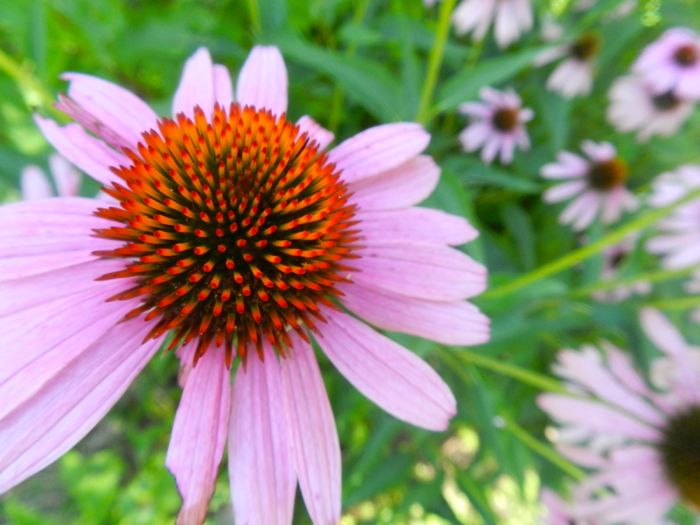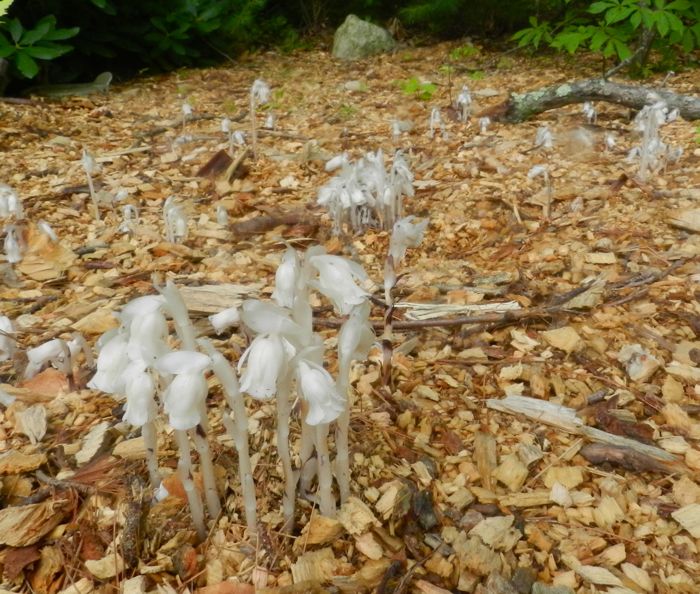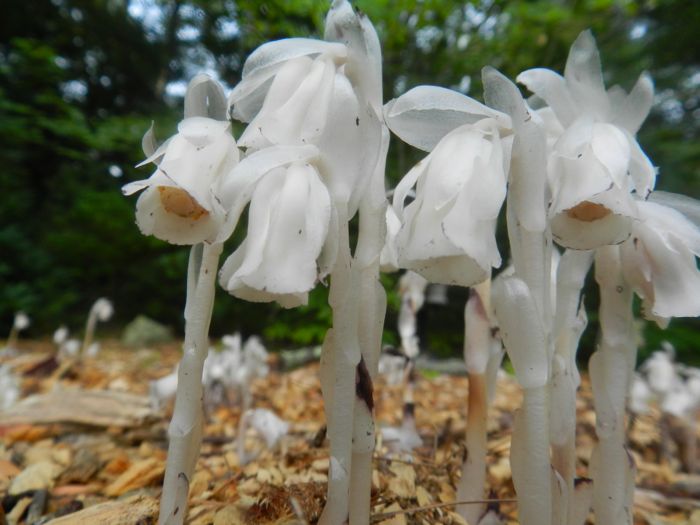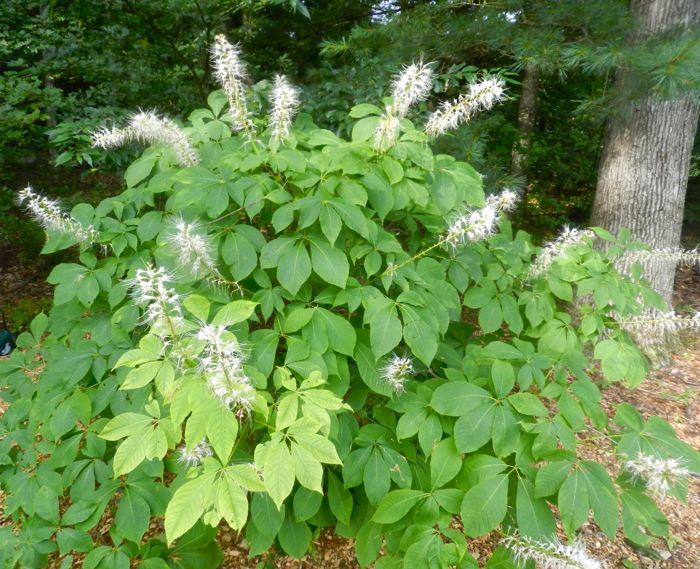As much as the technicolor flowers of mid-summer make the garden a joyous place,
right now my heart is with plants off to the side of my property, at the edge of the driveway, on the verge of the woodland. They are easy to overlook, but as I walk to the mailbox I see something that makes me pause.
Pushing up out of the boring and suburban-looking wood chips are these ephemeral fungi, the Indian Pipe.
Up-close they have an otherworldly beauty. Soon they’ll turn grey and shrivel, but at this moment, they are ghostlike and stunning.
Next to the Indian pipe is a green bush with white blooms. If you bother to walk up to it, you’ll be rewarded by a floral scent that is as complex as an expensive perfume.
It is the Bottlebrush Buckeye, a native shrub. I’m not the only one pulled in by the scent of the flowers. Like many under-appreciated native plants, it is a magnet for bees and supports essential pollinators. I can’t think of a prettier sight in a garden than this.:






How beautiful….and the bee is too! Thank you for sharing.
Wow, I’m impressed with your camera! That last photo is a National Geographic winner for sure.
OMGosh – that last pic with the bee is WONDERFUL! So close n clear. You framed it just right. Find a photography contest cuz this is a winner for sure!
Seeing the bee reminds me of what has been going on at my place. It has been so hot and so dry for so long that the bees and the wasps, especially the wasps, have taken over my garden pond. Feeding the fish has become an adventure. Last night there were literally hundreds of wasps flying around the pond, they crawl down the water iris to water to drink. I’ve never seen this before.
Forgot my question, is that red on the bee pollen?
Yes, that’s the pollen. Any bee keepers want to chime in and tell us what we’re seeing?
That’s a fabulous picture, Terry! Yes, that’s pollen, which attaches itself to hairs on the bees’ back legs while they are collecting nectar and is carried from flower to flower–the basics of pollination. Pollen is also carried back to the hive and mixed with nectar to make “bee bread,” which is fed to developing bees in the comb. When we beekeepers see a lot of bees returning to the hive with their little saddlebags bulging with pollen, we know that the queen is laying and we have a healthy hive. I’d love to know what plant produces that red pollen; I’ve never seen any that brilliant shade!
Beautiful photos!
You could make your backyard farm complete with…Honey Bees. I hope to get two hives up and running next Spring.
Your photos are spectacular. I’m always amazed at how quickly mushrooms can appear. And just as quickly disappear. Will chickens know what mushrooms to avoid? Sometimes I see mine come up on one in the yard and I’m always worried that it may be toxic to them if they eat it. And like Ken, I’ve never seen so many wasps visit my water fountains as I have this year. Poor thirsty little guys.
As long as your chickens are getting their fill of pellets and have a variety of forage when they go out, they leave the poisonous stuff alone. They get in trouble when they’re hungry or bored and there’s only one choice. Plenty of mushrooms around here, and my hens have never gotten sick.
I have to agree, that last photo is just amazing!
I have been caught up in my own flock recently and not commented as much although I always catch up on your posts and the comments when I have a moment.
Your photos put mine to shame though, they are always excellent. I agree they would do well in a contest. The bee photo is superb as were the peach and tomato and the older hens before that. Your photos are as much of a joy as your words.
I also think that the Indian Pipes are beautiful. I haven’t been out in our woods recently so haven’t seen any this year. I’ll have to take a walk to look for them.
I agree that bee photo is amazing. What settings on your camera?
I do so enjoy your blog.
I’ve never heard of Indian Pipe fungus before. It is beautiful. Not something we get in Britain I think, even under another name
Terry, Indian pipe, or corpse plant, monotropa uniflora, is one of my favorites, too. The bloggers a the lodge high on mt leconte tn (site temporarily down), say the name comes from the Native American gods who turned the chiefs into these plants because they would not make peace with the other tribes. We have it and pine sap, which is red, and beech drops in Mississippi. There is a squaw corn, cone shaped, in the Smokies and Blue Ridge.
Here is the legend of Indian pipe as it appears on the leconte lodge website, for July 8th 2012. There are lots of other beautiful photos of sunset and rise, bears, and plants around the mountain and goings on. It is still only 70 on the mt and 43 at night. A caretaker stays in the lodge all winter, even when it is closed to tourists and blogs. They are all solar powered, propane, and kerosene. Llamas bring food and clean linens up several times a week and get snacks of pancakes from breakfast.
According to legend, a long time ago, before selfishness came into the world, the Cherokee people were happy sharing the hunting and fishing places with their neighbors. All this changed when Selfishness came into the world and man began to quarrel. The Cherokee Indians quarreled with tribes on the east. Finally the chiefs of several tribes met in council to try to settle the dispute. They smoked the pipe and continued to quarrel for seven days and seven nights. This displeased the Great Spirit because people are not supposed to smoke the pipe until they make peace. As he looked upon the old men with heads bowed, he decided to do something to remind people to smoke the pipe only at the time they make peace.
The Great Spirit turned the old men into greyish flowers now called ~Indian Pipes~ and he made them grow where friends and relatives had quarreled. He made the smoke hang over these mountains until all the people all over the world learn to live together in peace.
Thanks for sharing this, Vicky.
That red pollen is cool. What plant is that coming from?
No idea! Anyone have the answer?